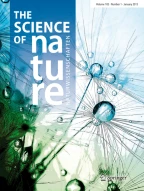Abstract
Recent studies showed that nectar odors brought back by honeybee foragers can be learned associatively inside the hive. In the present study, we focused on the learning abilities of bees, which directly interact via trophallaxis with the incoming nectar foragers: the workers that perform nectar-receiving tasks inside the hive. Workers that have received food directly from foragers coming back from a feeder offering either unscented or scented sugar solution [phenylacetaldehyde (PHE) or nonanal diluted] were captured from two observational hives, and their olfactory memories were tested using the proboscis extension response paradigm. Bees that have received scented solution from incoming foragers showed significantly increased response frequencies for the corresponding solution odor in comparison with those that have received unscented solution. No differences in the response frequencies were found between food odors and colonies. The results indicate that first-order receivers learn via trophallaxis the association between the scent and the sugar solution transferred by incoming foragers. The implications of these results should be considered at three levels: the operational cohesion of bees involved in foraging-related tasks, the information propagation inside the hive related to the floral type exploited, and the putative effect of these memories on future preferences for resources.
References
Beekman M (2005) How long will honey bees (Apis mellifera L.) be stimulated by scent to revisit past-profitable forage sites? J Comp Physiol A 191:1115–1120
Bouton ME, Moody EW (2004) Memory processes in classical conditioning. Neurosci Biobehav Rev 28:663–674
Bitterman ME, Menzel R, Fietz A, Schafer S (1983) Classical-conditioning of proboscis extension in honeybees (Apis mellifera). J Comp Psychol 97:107–119
Farina WM, Wainselboim AJ (2001) Thermographic recordings show that honeybees may receive nectar from foragers even during short trophallactic contacts. Insectes Soc 48:360–362
Farina WM, Grüter C, Diaz PC (2005) Social learning of floral odors inside the honeybee hive. Proc Biol Sci 273:1923–1928
Gil M, De Marco R (2005) Olfactory learning by means of trophallaxis in Apis mellifera. J Exp Biol 208:671–680
Goyret J, Farina WM (2005) Non-random nectar unloading interactions between foragers and their receivers in the honeybee hive. Naturwissenschaften 92:440–443
Grüter C, Acosta LE, Farina WM (2006) Propagation of olfactory information within the honeybee hive. Behav Ecol and Sociobiol 60:707–715
Guerrieri F, Schubert M, Sandoz JC, Giurfa M (2005) Perceptual and neural olfactory similarity in honeybees. PLoS Biol 3(4):e60
Johnson DL, Wenner AM (1966) A relationship between conditioning and communication in honey bees. Anim Behav 14:261–265
Knudsen JT, Tollsten L, Bergstrom LG (1993) Floral scents—a checklist of volatile compounds isolated by headspace techniques. Phytochemistry 33:253–280
Menzel R (1999) Memory dynamics in the honeybee. J Comp Physiol A 185:323–340
Ribbands CR (1954) Communication between honeybees: the response of crop-attached bees to the scent of their crop. Proc R Entomol Soc Lond A 29:141–144
Seeley TD (1995) The wisdom of the hive. Harvard University Press, Cambridge, MA
Sokal R, Rohlf F (1981) Biometry, 2nd edn. Freeman, New York
von Frisch K (1919) Über den Geruchsinn der Biene und seine blütenbiologische Bedeutung. Zool Jahrb 37:2–238
von Frisch K (1967) The dance language and orientation in honey bees. Harvard University Press, Cambridge, MA
Wenner AM, Wells PH, Johnson DL (1969) Honey bee recruitment to food sources: olfaction or language? Science 164:84–86
Zar JH (1999) Biostatistical analysis, 4th edn. Prentice-Hall, New Jersey
Acknowledgments
We are indebted to A. Arenas and H. Verna for their technical assistance and to one anonymous referee for the helpful comments on the earlier versions of the manuscript. This study was supported by funds from ANPCYT (01-12319) and the University of Buenos Aires (X 036) to WMF. CG is supported by the VDRB, commission for travel grants of the SANW, Dr. De Giacomi Stiftung, Basler Stiftung für biologische Forschung and Berner Hochschulstiftung. The present study complies with the current laws of the state country in which experiments were performed.
Author information
Authors and Affiliations
Corresponding author
Rights and permissions
About this article
Cite this article
Farina, W.M., Grüter, C., Acosta, L. et al. Honeybees learn floral odors while receiving nectar from foragers within the hive. Naturwissenschaften 94, 55–60 (2007). https://doi.org/10.1007/s00114-006-0157-3
Received:
Revised:
Accepted:
Published:
Issue Date:
DOI: https://doi.org/10.1007/s00114-006-0157-3
